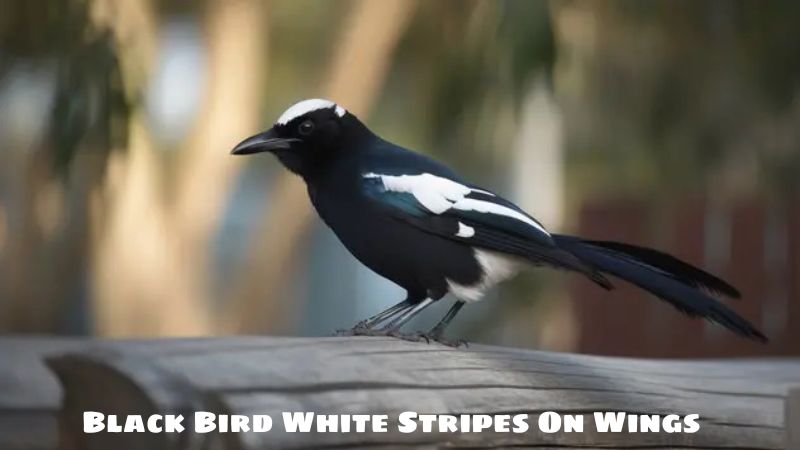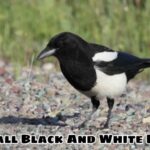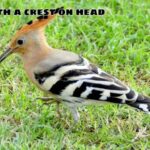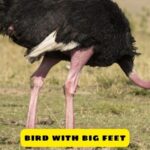Black birds with white stripes on their wings are one of the very special and easily identifiable birds in the animal world. With their black plumage and brilliant white markings on their wings and back, they create a very unique image. These birds usually live in natural environments, such as forests or grasslands, where they can search for food and build nests.
The mixture of colors on the feathers of black birds with white stripes on the wings not only helps them blend into their living environment but is also a highlight of the diversity and charm of nature. Let’s explore with Exoticbirdscorner the characteristics of black bird white stripes on wings!
Describe the characteristics of black bird white stripes on wings on their wings
The black bird with white stripes on the wings, also known by other names such as the large water paddle bird, is a medium-sized bird, with a body length ranging from 20 to 30 cm. They possess shiny black fur, creating a strong and luxurious appearance. The highlight of this bird’s plumage is the pure white stripes running horizontally on the wings, creating an impressive contrast and easy recognition.
The black bird’s beak has white stripes on its wings and is quite pointed, jet black in color, adapted for catching prey and gnawing on food. Their legs are short but strong, helping birds easily move on tree branches and the ground.
The eyes are large, round and black, showing flexibility and agility in observing and moving. The bird’s long black tail can spread out when flying or perching, helping the bird maintain balance and navigate better.
In general, black birds with white stripes on their wings have a unique and eye-catching appearance with pure black feathers and prominent white stripes. They are intelligent, agile birds and have the ability to adapt well to diverse habitats.

Classification of black birds with white stripes on the wings
Although they have a similar appearance with jet black plumage and white stripes on their wings, black birds with white stripes on their wings are actually a collection of many bird species belonging to different families. The two most common families are Passeridae and Turdidae.
1. Passeridae
- Passer montanus: A small bird, common in many areas of the world. They are small in size, have clear white stripes on their wings, often gather in large flocks and move continuously.
- Bamboo sparrow (Passer montanus): Similar to the field sparrow, but lives mainly in bamboo forests. The white stripes on the wings of the bamboo sparrow are shorter than those of the field sparrow.
2. Turdidae family
- Pycnonotus sinensis: Larger in size than sparrows, white stripes on the wings alternate with black stripes, creating a unique appearance. They often live singly or in pairs, preferring jungle or garden environments.
- Black warbler (Turdus merula): Jet black feathers, white stripes on wings are fainter than other birds. They often live in wild areas with few people.
In addition, there are some species of birds with black and white stripes on the wings belonging to other families such as the Swallow family (Hirundinidae), the Parrot family (Psittaciformes),… Each bird species has its own unique characteristics and behaviors, contributing to creating diversity for the ecosystem.
Classifying black birds with white stripes on their wings needs to be based on many factors such as size, color, feather pattern, living habits, habitat, etc. To be able to accurately identify bird species, you should Refer to specialized ornithological literature or seek help from experts.
Distribution and habitat of blackbirds with white stripes on the wings
Blackbirds with white stripes on their wings are widely distributed worldwide, except for cold Antarctica. They are most concentrated in temperate and tropical areas, where the climate is warm and food sources are abundant. Thanks to its good adaptability, this bird can live in many different habitats, including:
- Forests: Dense forests provide blackbirds with white stripes on their wings abundant food from insects, berries and small animals. They often nest on high tree branches and use the canopy for shelter.
- Orchards: Orchards, flower gardens and parks are also popular habitats for blackbirds with white stripes on their wings. They forage for food from flowers, ripe fruits and insects in the garden.
- Fields: Black birds with white stripes on their wings often visit rice fields, corn and other crops to forage. They catch insects that harm plants and contribute to crop protection.
Residential areas: Blackbirds with white stripes on their wings can also live in residential areas, especially in places with many trees and food sources. They often nest on roofs, attics or other structures.
Black bird behavior with white stripes on the wings
Black birds with white stripes on their wings tend to live in flocks or pairs. When living in herds, they often gather in large groups and move continuously to find food. When living in pairs, they often stick together throughout the breeding season and work together to care for their offspring.
This bird often picks food from trees, ground and bushes. They use their sharp beaks to catch insects, worms, and pick up seeds and berries. The diet of blackbirds with white stripes on their wings is quite diverse, including:
- Seeds: Rice seeds, corn, millet,… are important food sources for blackbirds with white stripes on their wings, especially in winter when insect food sources are scarce.
- Fruit: They like to eat succulent fruits such as strawberries, raspberries, blueberries,…
- Insects: Insects, larvae, beetles,… are a rich source of protein food for black birds with white stripes on their wings, helping them provide energy for life activities.
- Insects: Insects are the favorite food of young birds, helping them grow quickly.
Black birds with white stripes on their wings have chirping sounds that are diverse and change with the seasons. During the breeding season, their songs become more intense and exciting to attract mates. The singing of black birds with white stripes on their wings contributes to creating lively sounds for nature.
This bird often nests on trees, roofs, hollows or other structures. Their nests are made from twigs, dry grass, feathers and other soft materials. Blackbirds with white stripes on their wings lay 4-6 eggs per clutch and both male and female birds together incubate the eggs and care for the young.
Epilogue
Black Bird White Stripes On Wings are a classic example of harmony between color and nature. With their colorful black feathers and delicate white stripes stretching across their wings, they attract attention and create a very special image in the animal world.
This color arrangement not only helps birds camouflage effectively in their natural habitat, but is also a symbol of biodiversity and the richness of wild life. Black birds with white stripes on their wings are a clear testament to the integration and intense life of nature.





